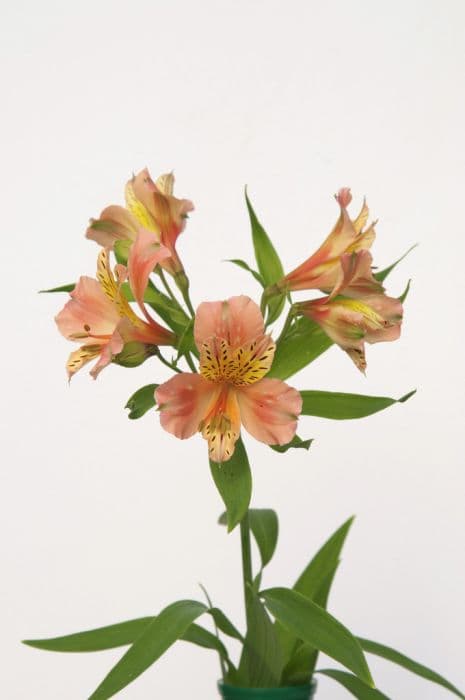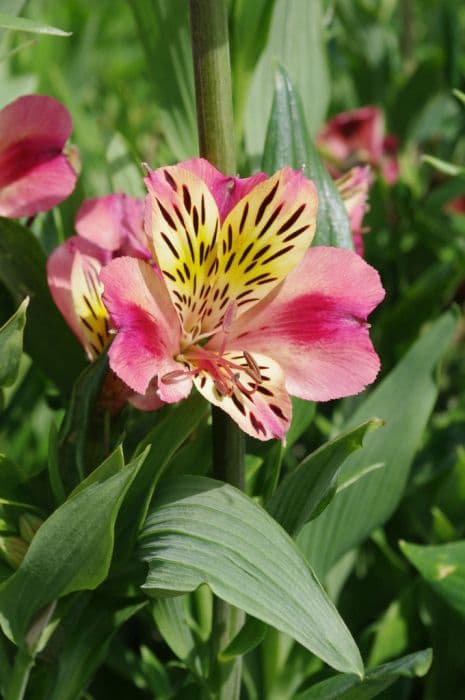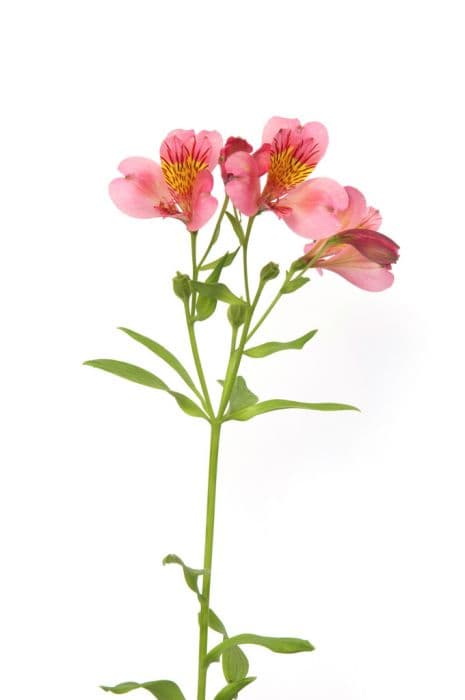Peruvian Lily Alstroemeria 'Phoenix' (v)

ABOUT
Alstroemeria 'Phoenix', commonly known as Peruvian Lily or Lily of the Incas, is a striking plant cherished for its beautiful and colorful flowers. The appearance of this variety is notable for its vibrant, trumpet-shaped flowers that exhibit a stunning blend of warm hues, including reds, oranges, yellows, and sometimes touches of pink. The blossoms generally display multiple shades and will often feature intricate flecking or streaking that resembles brush strokes, providing a unique and artistic aspect to each flower. These flowers cluster together at the top of slender, green stems, which are adorned with narrow, lance-shaped leaves that curve gracefully, giving the plant an overall appearance of lushness and abundance. The foliage is typically a rich green, which serves as a perfect complement to the vivid colors of the blossoms, enhancing their brilliance. Peruvian Lily blooms are well-loved not only for their eye-catching colors but also for their resilience and long vase life, making them popular choices for cut floral arrangements. The plant exudes a lush and tropical vibe, bringing an exotic touch to gardens, containers, or as cut flowers in arrangements. Each individual flower consists of six petals, which contribute to a symmetrical and balanced look that is aesthetically pleasing. Moreover, the Peruvian Lily can bloom for several months under the right conditions, providing a long-lasting display of color. The plant's ability to produce numerous buds and flowers is yet another reason for its popularity among flower enthusiasts. With its dazzling appearance and enduring blooms, Alstroemeria 'Phoenix' is a captivating plant that adds a burst of color and life wherever it is grown.
About this plant
 Names
NamesFamily
Alstroemeriaceae
Synonyms
Peruvian Lily, Lily of the Incas, Parrot Lily
Common names
Alstroemeria 'Phoenix'
 Toxicity
ToxicityTo humans
The Alstroemeria, also known as Peruvian Lily, generally has a low level of toxicity to humans. However, if ingested, it may cause mild gastrointestinal symptoms such as nausea and vomiting.
To pets
The Peruvian Lily can be mildly toxic to cats and dogs if ingested. The symptoms of poisoning may include vomiting, diarrhea, and drooling. In most cases, the ingestion of this plant would cause gastrointestinal upset but is not expected to result in severe poisoning or long-term health issues for pets.
 Characteristics
CharacteristicsLife cycle
Perennials
Foliage type
Deciduous
Color of leaves
Green
Flower color
Mixed
Height
2-3 feet (60-90 cm)
Spread
1-2 feet (30-60 cm)
Plant type
Bulb
Hardiness zones
7
Native area
South America
Benefits
 General Benefits
General Benefits- Long-lasting blooms: The Alstroemeria 'Phoenix' is known for its long flowering period, providing vibrant colors for an extended time.
- Attracts Pollinators: It draws bees, butterflies, and other beneficial insects, which are vital for pollination and a healthy ecosystem.
- Landscape Versatility: Can be used in borders, containers, and as cut flowers, making it versatile for different garden designs.
- Drought Tolerance: Once established, it can tolerate periods of drought, making it suitable for regions with water scarcity.
- Easy Propagation: Propagates easily through division, allowing gardeners to create more plants from a single purchase.
- Minimal Pest Issues: Generally resistant to many pests, reducing the need for chemical treatments in the garden.
 Medical Properties
Medical PropertiesThis plant is not used for medical purposes.
 Air-purifying Qualities
Air-purifying QualitiesThis plant is not specifically known for air purifying qualities.
 Other Uses
Other Uses- Floral Art: Alstroemeria 'Phoenix' can be used for intricate floral art designs due to its striking colors and complex petal patterns.
- Photography Subjects: Their vivid appearance makes them excellent subjects for photography, especially macro photography.
- Edible Decoration: Although not widely known, the petals of Alstroemeria are edible and can be used as a colorful garnish on salads and desserts.
- Craft Projects: Dried Alstroemeria flowers can be used in craft projects such as making bookmarks, cards, or pressed flower art.
- Dye Source: The flowers can be used to create natural dyes for fabric or paper, though this is not a common practice.
- Eco-friendly Confetti: Dried petals of Alstroemeria 'Phoenix' can be used as biodegradable confetti for celebrations.
- Book Decoration: Pressed Alstroemeria flowers can be used to embellish journals, notebooks, or diaries.
- Flower Arranging Classes: Alstroemeria 'Phoenix' is ideal for teaching flower arranging techniques due to its resilience and long vase life.
- Gift Wrapping Embellishments: Fresh or dried Alstroemeria flowers can be used to decorate gift packages for a personal touch.
- Fashion Accessories: The flowers can be incorporated into fashion accessories like hairpins, pendants, or brooches.
Interesting Facts
 Feng Shui
Feng ShuiThe Peruvian Lily is not used in Feng Shui practice.
 Zodiac Sign Compitability
Zodiac Sign CompitabilityThe Peruvian Lily is not used in astrology practice.
 Plant Symbolism
Plant Symbolism- Friendship: Alstroemeria, commonly known as Peruvian Lily, often represents strong bonds of friendship due to its leaves, which twist as they grow, symbolizing the intertwined nature of relationships.
- Devotion: Peruvian Lily signifies devotion and mutual support, suggesting a commitment to support loved ones through all of life's challenges.
- Wealth and Prosperity: Its multiple blossoms and long-lasting nature make it a symbol of wealth and abundance, often used to wish someone a prosperous life.
- Fortitude: The resilience and longevity of the Peruvian Lily blooms are seen as a symbol of endurance and the ability to cope with adversity.
- Achievement: Given as a congratulations, the Peruvian Lily can represent achievement and the triumph of reaching one’s goals, akin to the bird Phoenix rising from its ashes.
 Water
WaterWater the Peruvian Lily moderately, ensuring consistent moisture but avoiding waterlogged conditions. During the active growing season, typically spring through summer, water the plant deeply once a week with about 1 to 1.5 gallons, depending on the size of the plant and the weather conditions. In the cooler months, reduce watering to every other week, monitoring the soil moisture; it should dry slightly between waterings. Overwatering can lead to root rot, so it's important that the soil drains well.
 Light
LightPeruvian Lilies thrive best in bright, indirect sunlight. They should be placed where they can receive morning sun and afternoon shade or dappled sunlight throughout the day. Avoid direct, harsh afternoon sun as it can scorch the leaves. A spot near an east-facing window or under the light shade of a tree is ideal for outdoor plants.
 Temperature
TemperaturePeruvian Lilies prefer temperatures between 65 and 80 degrees Fahrenheit. They can tolerate temperatures as low as 50 degrees Fahrenheit but should be protected from frost. Conversely, they can withstand occasional highs up to 90 degrees Fahrenheit, but consistently hot temperatures can stress the plant.
 Pruning
PruningPrune Peruvian Lilies to remove spent flower stems and encourage repeat blooming. Cut back the entire stem at the base after the flowers have faded, which can be done periodically throughout the blooming season. In late fall or early winter, after the growing season has ended, trim back any dead or yellow foliage to tidy up the plant and prepare it for dormancy.
 Cleaning
CleaningAs needed
 Soil
SoilPeruvian Lily thrives in a fertile, well-draining soil mix with a pH of 6 to 7. Incorporate organic matter such as compost or peat moss to improve texture and nutrient content.
 Repotting
RepottingPeruvian Lily should be repotted every 2 to 3 years to refresh the soil and accommodate root growth. Avoid disturbing the roots too much during repotting.
 Humidity & Misting
Humidity & MistingPeruvian Lily prefers moderate to high humidity levels, but can tolerate average household humidity conditions. Aim for a humidity level around 40-60%.
 Suitable locations
Suitable locationsIndoor
Provide bright, indirect light and well-draining soil.
Outdoor
Plant in partial shade with shelter from strong winds.
Hardiness zone
7-10 USDA
 Life cycle
Life cycleThe Peruvian Lily 'Phoenix' begins its life cycle as a tuberous rhizome planted in early spring. Following sprouting, it enters a vegetative stage characterized by the growth of elongated, lance-shaped, green leaves and the development of a strong stem structure. As the plant matures, flower buds develop at the stem tips, leading to the blooming stage where vibrant flowers showcasing a mix of red, orange, and yellow hues emerge, typically in late spring or early summer. After pollination, which may be assisted by insects attracted to the blooms, the plant produces a dry, capsule-like fruit containing seeds. Post blooming, energy is redirected to the roots for tuber strengthening during the plant's dormant period in winter. If conditions are not suitable for seed development or if propagation by division is preferred, the plant will continue its life cycle the following season by the resumption of vegetative growth from the rhizomes.
 Propogation
PropogationPropogation time
Spring-Early Summer
The Alstroemeria 'Phoenix', commonly known as Peruvian Lily or Lily of the Incas, is best propagated by division of rhizomes. This process tends to be most successful when carried out in the spring as the plant comes out of dormancy and begins to show new growth. When dividing, carefully lift the clump of rhizomes from the ground using a spade or fork, ensuring minimal damage is done to the roots and shoots. Once removed, gently tease apart individual rhizomes that have at least one or two growth points or 'eyes'. You can then replant these divisions immediately, maintaining a depth where the top of the rhizome is approximately 2 inches (5 centimeters) below the soil surface. Water the newly planted divisions thoroughly to help establish them in their new location. This method allows gardeners to propagate and spread their Alstroemeria 'Phoenix' effectively, maintaining the health and vigor of the original plant.




![Peruvian lily [H.R.H. Princess Alice]](/_next/image?url=https%3A%2F%2Fplants-admin.emdemapps.com%2Fimages%2Fplants%2F%2Fimages%2F604b55e81c8b0.png&w=640&q=75)
![Peruvian lily [Indian summer]](/_next/image?url=https%3A%2F%2Fplants-admin.emdemapps.com%2Fimages%2Fplants%2F%2Fimages%2F604b616bc746b.png&w=640&q=75)
![Peruvian lily [Inticancha Creamy Dark Pink]](/_next/image?url=https%3A%2F%2Fplants-admin.emdemapps.com%2Fimages%2Fplants%2F%2Fimages%2F604b5e98bea7c.png&w=640&q=75)
![Peruvian lily [Inticancha Dark Purple]](/_next/image?url=https%3A%2F%2Fplants-admin.emdemapps.com%2Fimages%2Fplants%2F%2Fimages%2F604b5381bb78f.png&w=640&q=75)
![Peruvian lily [Inticancha Imala]](/_next/image?url=https%3A%2F%2Fplants-admin.emdemapps.com%2Fimages%2Fplants%2F%2Fimages%2F604b619b522ba.png&w=640&q=75)
![Peruvian lily [Inticancha Red]](/_next/image?url=https%3A%2F%2Fplants-admin.emdemapps.com%2Fimages%2Fplants%2F%2Fimages%2F604b5aebac273.png&w=640&q=75)